中国传统文化书法英文讲解
- 格式:ppt
- 大小:5.36 MB
- 文档页数:22
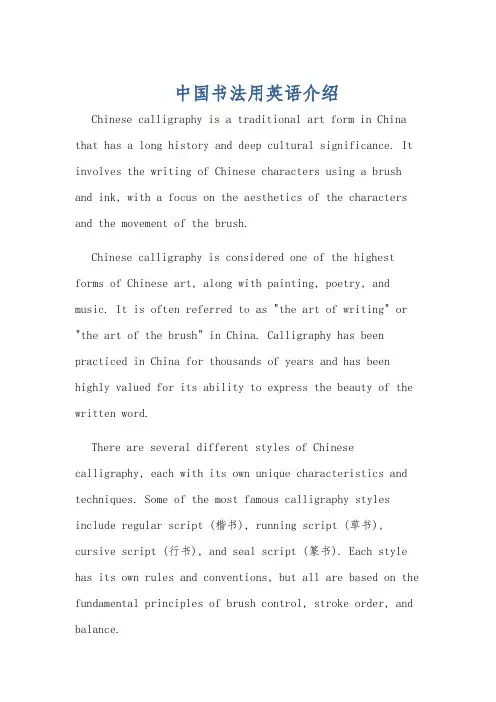
中国书法用英语介绍Chinese calligraphy is a traditional art form in China that has a long history and deep cultural significance. It involves the writing of Chinese characters using a brush and ink, with a focus on the aesthetics of the characters and the movement of the brush.Chinese calligraphy is considered one of the highest forms of Chinese art, along with painting, poetry, and music. It is often referred to as "the art of writing" or "the art of the brush" in China. Calligraphy has been practiced in China for thousands of years and has been highly valued for its ability to express the beauty of the written word.There are several different styles of Chinese calligraphy, each with its own unique characteristics and techniques. Some of the most famous calligraphy styles include regular script (楷书), running script (草书), cursive script (行书), and seal script (篆书). Each style has its own rules and conventions, but all are based on the fundamental principles of brush control, stroke order, and balance.One of the key elements of Chinese calligraphy is the use of brush strokes to create expressive and dynamic characters. Calligraphers pay close attention to the thickness, speed, and direction of each stroke, as well as the overall composition of the characters on the page. The result is a work of art that not only conveys the meaning of the text but also embodies the emotions and intentions of the calligrapher.In addition to its artistic value, Chinese calligraphyis also highly regarded for its cultural and spiritual significance. Calligraphy is often used in traditional Chinese ceremonies and rituals, such as weddings, funerals, and the Lunar New Year. It is also considered a form of meditation and self-expression, allowing practitioners to cultivate mindfulness and focus through the practice of writing.Overall, Chinese calligraphy is a rich and complex art form that reflects the beauty, history, and cultural heritage of China. It continues to be practiced and appreciated by people around the world, serving as a bridge between past and present, tradition and modernity.中国书法是中国传统艺术形式之一,具有悠久的历史和深厚的文化内涵。
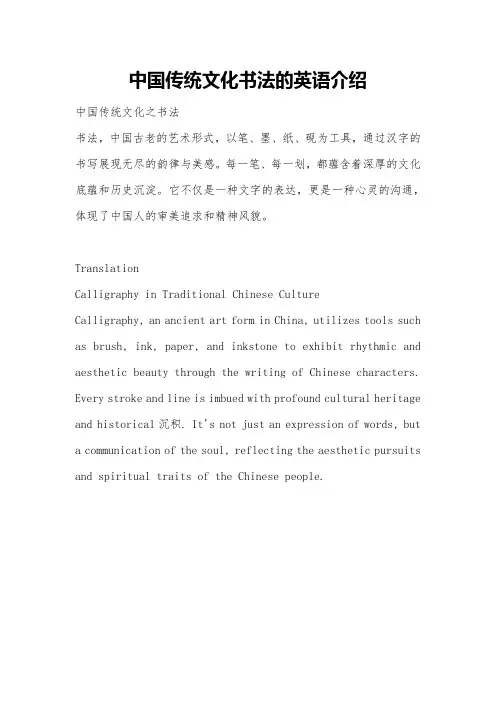
中国传统文化书法的英语介绍
中国传统文化之书法
书法,中国古老的艺术形式,以笔、墨、纸、砚为工具,通过汉字的书写展现无尽的韵律与美感。
每一笔、每一划,都蕴含着深厚的文化底蕴和历史沉淀。
它不仅是一种文字的表达,更是一种心灵的沟通,体现了中国人的审美追求和精神风貌。
Translation
Calligraphy in Traditional Chinese Culture
Calligraphy, an ancient art form in China, utilizes tools such as brush, ink, paper, and inkstone to exhibit rhythmic and aesthetic beauty through the writing of Chinese characters. Every stroke and line is imbued with profound cultural heritage and historical沉积. It's not just an expression of words, but a communication of the soul, reflecting the aesthetic pursuits and spiritual traits of the Chinese people.。
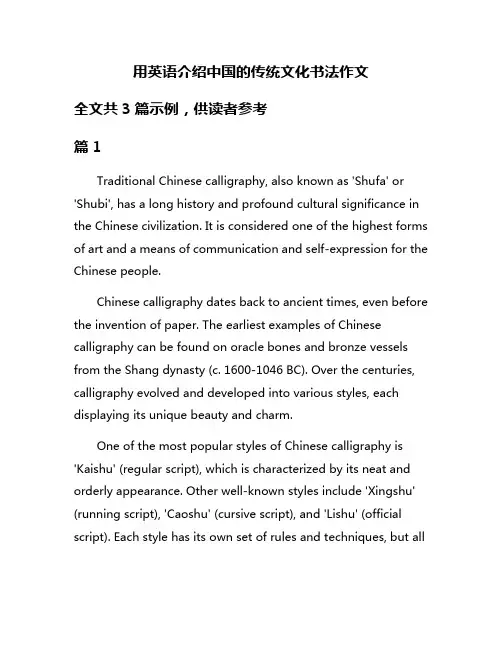
用英语介绍中国的传统文化书法作文全文共3篇示例,供读者参考篇1Traditional Chinese calligraphy, also known as 'Shufa' or'Shubi', has a long history and profound cultural significance in the Chinese civilization. It is considered one of the highest forms of art and a means of communication and self-expression for the Chinese people.Chinese calligraphy dates back to ancient times, even before the invention of paper. The earliest examples of Chinese calligraphy can be found on oracle bones and bronze vessels from the Shang dynasty (c. 1600-1046 BC). Over the centuries, calligraphy evolved and developed into various styles, each displaying its unique beauty and charm.One of the most popular styles of Chinese calligraphy is'Kaishu' (regular script), which is characterized by its neat and orderly appearance. Other well-known styles include 'Xingshu' (running script), 'Caoshu' (cursive script), and 'Lishu' (official script). Each style has its own set of rules and techniques, but allshare the common goal of conveying beauty and meaning through strokes and lines.Chinese calligraphy is not just about writing characters; it is also about expressing emotions, thoughts, and cultural values. Calligraphy artists often use brush and ink to create intricate and elegant compositions that reflect their personalities and beliefs. The art of calligraphy requires patience, practice, and mastery of the brush, ink, and paper.In Chinese culture, calligraphy plays a vital role in various aspects of life, from everyday communication to artistic expression. It is often used in poems, paintings, inscriptions, and other forms of art. Calligraphy is also used in ceremonies, such as weddings, funerals, and official events, to convey blessings, wishes, and gratitude.Chinese calligraphy has a profound influence on other Asian cultures, such as Japanese and Korean calligraphy. It has inspired artists, writers, and scholars around the world to appreciate the beauty and elegance of Chinese characters.In conclusion, Chinese calligraphy is more than just a form of writing; it is a reflection of Chinese culture, history, and values. It embodies the spirit of harmony, balance, and grace that define the essence of Chinese civilization. Through calligraphy, one cangain a deeper understanding of the beauty and depth of the Chinese language and culture.篇2Chinese calligraphy, often referred to as the art of writing, is a traditional and highly esteemed form of visual art in China. With a long history that dates back to ancient times, calligraphy is not only a means of communication, but also a unique art form that expresses the emotions and personalities of the calligrapher.Chinese calligraphy is typically practiced with a brush and ink on paper or silk. The calligrapher uses various brush strokes and techniques to create characters that are not only visually appealing, but also imbued with cultural and historical significance.One of the key features of Chinese calligraphy is the emphasis on brushwork and the flow of energy in each stroke. Calligraphers must have a deep understanding of the structure and composition of Chinese characters, as well as a mastery of different styles and scripts. There are five main styles of Chinese calligraphy – seal script, clerical script, regular script, running script, and cursive script – each with its own distinct characteristics and aesthetic appeal.Chinese calligraphy is not only a form of artistic expression, but also a way to cultivate one's inner self and moral character. Practicing calligraphy requires patience, discipline, and a deep appreciation for Chinese culture and history. It is often said that the way a person writes reflects their personality and inner state of mind, making calligraphy a form of self-expression and introspection.In addition to its aesthetic and cultural significance, Chinese calligraphy is also valued for its practical purposes. Historically, calligraphy was used for official documents, letters, and artistic inscriptions. Today, calligraphy continues to be used in various contexts, including signage, banners, and artwork.Overall, Chinese calligraphy is a unique and powerful art form that embodies the rich cultural heritage of China. Its beauty, grace, and depth of meaning continue to inspire and captivate people around the world, making it a timeless and enduring symbol of Chinese culture.篇3IntroductionChinese calligraphy, a traditional art form deeply rooted in Chinese culture, is not just a means of communication but also aform of artistic expression. It has a history dating back thousands of years and continues to be highly valued and respected in modern-day China.Historical BackgroundThe origins of Chinese calligraphy can be traced back to around 2000 BCE, during the Shang dynasty. It was originally used for inscriptions on oracle bones, which were used for divination purposes. Chinese calligraphy developed over the centuries, with various styles and forms emerging during different dynasties.Key Techniques and StylesChinese calligraphy is characterized by its use of brush and ink on paper or silk. It utilizes five basic strokes: horizontal, vertical, left-falling, right-falling, and hook. Each stroke is carefully executed to create harmonious and balanced compositions.There are several main styles of Chinese calligraphy, including seal script, clerical script, regular script, running script, and cursive script. Each style has its own unique characteristics and is often associated with different dynasties or calligraphers.Importance and InfluenceChinese calligraphy is considered a highly respected art form in China and plays a significant role in Chinese culture. It is often seen as a reflection of the calligrapher's personality, emotions, and inner thoughts. Calligraphy is also closely linked to other traditional arts, such as poetry, painting, and seal carving.In modern times, Chinese calligraphy continues to be practiced and appreciated by people of all ages. It is commonly taught in schools in China and is seen as a way to cultivate discipline, patience, and appreciation for traditional Chinese culture.ConclusionChinese calligraphy is a timeless art form that has been passed down through generations and continues to be cherished by people around the world. Its beauty lies in its simplicity, elegance, and ability to convey complex emotions and thoughts through the stroke of a brush. As one of the oldest and most revered art forms in Chinese culture, calligraphy will undoubtedly continue to inspire and captivate audiences for generations to come.。
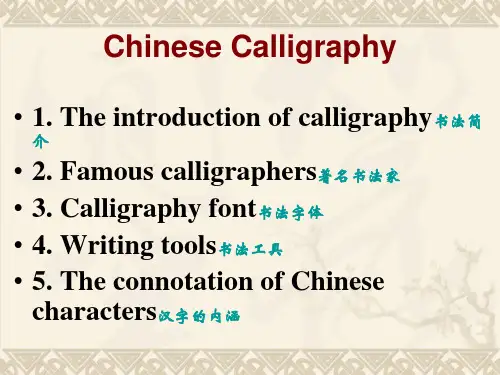
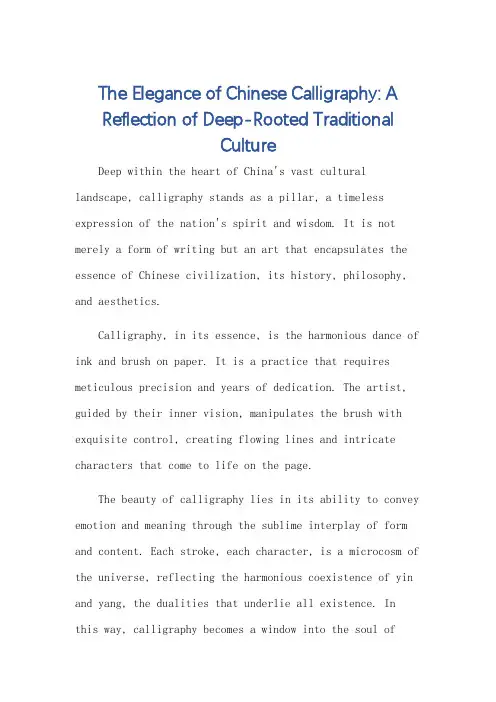
The Elegance of Chinese Calligraphy: AReflection of Deep-Rooted TraditionalCultureDeep within the heart of China's vast cultural landscape, calligraphy stands as a pillar, a timeless expression of the nation's spirit and wisdom. It is not merely a form of writing but an art that encapsulates the essence of Chinese civilization, its history, philosophy, and aesthetics.Calligraphy, in its essence, is the harmonious dance of ink and brush on paper. It is a practice that requires meticulous precision and years of dedication. The artist, guided by their inner vision, manipulates the brush with exquisite control, creating flowing lines and intricate characters that come to life on the page.The beauty of calligraphy lies in its ability to convey emotion and meaning through the sublime interplay of form and content. Each stroke, each character, is a microcosm of the universe, reflecting the harmonious coexistence of yin and yang, the dualities that underlie all existence. Inthis way, calligraphy becomes a window into the soul ofChina, revealing the country's profound philosophical outlook and aesthetic sensibilities.Moreover, calligraphy is closely tied to China's rich history and literature. It has been used to record stories, poems, and historical events, serving as a vehicle for the transmission of knowledge and wisdom across generations.The classic works of ancient scholars and poets are often rendered in calligraphic scripts, making them not onlywords but also visual masterpieces.Today, calligraphy remains a vibrant and relevant partof Chinese culture. It is studied and practiced by millions, not only as an art form but also as a means of cultivating one's character and fostering inner peace. Calligraphy exhibitions and competitions are held regularly, attracting crowds of enthusiasts who come to admire the masterful brushwork and appreciate the deep cultural significance of this ancient art.In conclusion, Chinese calligraphy is a unique and enduring expression of the country's rich cultural heritage. It is a testament to the creativity and wisdom of theChinese people, and a powerful reminder of the enduring value of traditional culture in the modern world.**中国书法的优雅:深厚传统文化的体现**在中国博大精深的文化景观中,书法无疑是一根支柱,它是国家精神和智慧的永恒体现。

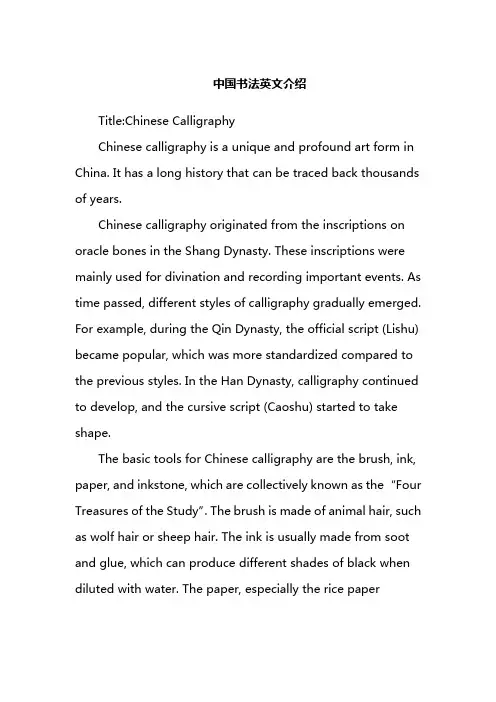
中国书法英文介绍Title:Chinese CalligraphyChinese calligraphy is a unique and profound art form in China. It has a long history that can be traced back thousands of years.Chinese calligraphy originated from the inscriptions on oracle bones in the Shang Dynasty. These inscriptions were mainly used for divination and recording important events. As time passed, different styles of calligraphy gradually emerged. For example, during the Qin Dynasty, the official script (Lishu) became popular, which was more standardized compared to the previous styles. In the Han Dynasty, calligraphy continued to develop, and the cursive script (Caoshu) started to take shape.The basic tools for Chinese calligraphy are the brush, ink, paper, and inkstone, which are collectively known as the “Four Treasures of the Study”. The brush is made of animal hair, such as wolf hair or sheep hair. The ink is usually made from soot and glue, which can produce different shades of black when diluted with water. The paper, especially the rice paper(Xuanzhi), has a special texture that is suitable for ink absorption. The inkstone is used for grinding the ink.There are five main styles of Chinese calligraphy, namely, seal script (Zhuanshu), official script (Lishu), regular script (Kaishu), running script (Xingshu), and cursive script (Caoshu). Seal script is often used for seals and has a very archaic and solemn appearance. Official script is more square - shaped and has clear strokes. Regular script is the most standardized style, with each stroke having a fixed shape and position. Running script is a combination of regular script and cursive script, with a flowing and natural rhythm. Cursive script is the most free - style, with the strokes often connected and abbreviated, showing the calligrapher's strong emotions and creativity.Chinese calligraphy is not only a form of writing but also a way of expressing the calligrapher's personality, mood, and aesthetic taste. It reflects Chinese philosophy and cultural values. For example, the balance and harmony in calligraphy strokes are in line with the concept of “Yin - Yang”in Chinese philosophy. Moreover, calligraphy is also an important part of Chinese cultural heritage. It has influenced other Asian countries' calligraphy and art forms.In conclusion, Chinese calligraphy is a remarkable art form that combines writing, art, and cultural connotations. It is a precious treasure of Chinese culture and has attracted the attention and admiration of people all over the world.。
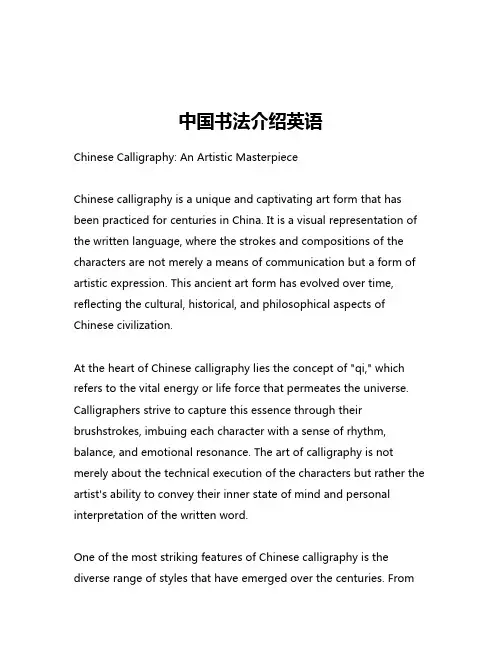
中国书法介绍英语Chinese Calligraphy: An Artistic MasterpieceChinese calligraphy is a unique and captivating art form that has been practiced for centuries in China. It is a visual representation of the written language, where the strokes and compositions of the characters are not merely a means of communication but a form of artistic expression. This ancient art form has evolved over time, reflecting the cultural, historical, and philosophical aspects of Chinese civilization.At the heart of Chinese calligraphy lies the concept of "qi," which refers to the vital energy or life force that permeates the universe. Calligraphers strive to capture this essence through their brushstrokes, imbuing each character with a sense of rhythm, balance, and emotional resonance. The art of calligraphy is not merely about the technical execution of the characters but rather the artist's ability to convey their inner state of mind and personal interpretation of the written word.One of the most striking features of Chinese calligraphy is the diverse range of styles that have emerged over the centuries. Fromthe bold and commanding "Kaishu" (regular script) to the fluid and expressive "Xingshu" (cursive script), each style reflects the unique aesthetic sensibilities and personal preferences of the calligrapher. The choice of script, the thickness and rhythm of the strokes, and the overall composition of the characters all contribute to the distinct character of a calligraphic work.The materials used in Chinese calligraphy are equally significant. The traditional tools include the brush, ink, paper, and inkstone, each of which plays a crucial role in the creative process. The brush, in particular, is an extension of the calligrapher's hand, allowing them to effortlessly manipulate the ink and create a wide range of expressive strokes. The quality of the paper, with its subtle textures and absorbent properties, also influences the final outcome, as it interacts with the ink to produce unique visual effects.The practice of Chinese calligraphy is not merely a technical exercise but a deeply introspective and spiritual process. Calligraphers often engage in meditative practices to cultivate a calm and focused state of mind, which is then reflected in the fluidity and harmony of their brushstrokes. The act of creating a calligraphic work is seen as a journey of self-discovery, where the artist's personal experiences, emotions, and philosophical beliefs are woven into the fabric of the artwork.Beyond its aesthetic appeal, Chinese calligraphy also serves as a window into the rich cultural heritage of China. The evolution of calligraphic styles is closely tied to the development of Chinese literature, history, and social customs. Each dynasty and region has its own distinctive calligraphic traditions, reflecting the unique cultural influences and artistic preferences of the time.In recent years, Chinese calligraphy has gained increasing global recognition, with artists and enthusiasts around the world exploring and appreciating this captivating art form. Contemporary calligraphers have also embraced new mediums and techniques, blending traditional practices with modern sensibilities to create innovative and thought-provoking works.In conclusion, Chinese calligraphy is a profound and multifaceted art form that continues to captivate and inspire audiences worldwide. From its deep-rooted cultural significance to its mesmerizing visual aesthetics, this ancient art form is a testament to the enduring creativity and spiritual essence of the Chinese people. Whether one is a seasoned connoisseur or a curious newcomer, the world of Chinese calligraphy offers a rich and rewarding journey of discovery and appreciation.。
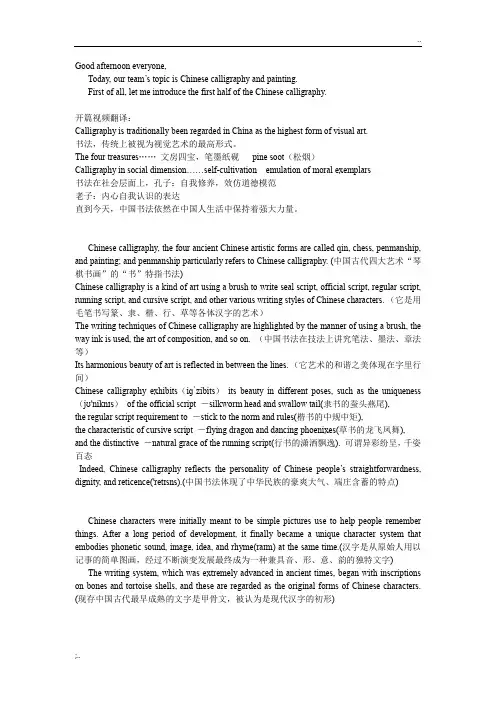
Good afternoon everyone,Today, our team’s topic is Chinese calligraphy and painting.First of all, let me introduce the first half of the Chinese calligraphy.开篇视频翻译:Calligraphy is traditionally been regarded in China as the highest form of visual art.书法,传统上被视为视觉艺术的最高形式。
The four treasures……文房四宝,笔墨纸砚pine soot(松烟)Calligraphy in social dimension……self-cultivation emulation of moral exemplars书法在社会层面上,孔子:自我修养,效仿道德模范老子:内心自我认识的表达直到今天,中国书法依然在中国人生活中保持着强大力量。
Chinese calligraphy, the four ancient Chinese artistic forms are called qin, chess, penmanship, and painting; and penmanship particularly refers to Chinese calligraphy. (中国古代四大艺术“琴棋书画”的“书”特指书法)Chinese calligraphy is a kind of art using a brush to write seal script, official script, regular script, running script, and cursive script, and other various writing styles of Chinese characters.(它是用毛笔书写篆、隶、楷、行、草等各体汉字的艺术)The writing techniques of Chinese calligraphy are highlighted by the manner of using a brush, the way ink is used, the art of composition, and so on. (中国书法在技法上讲究笔法、墨法、章法等)Its harmonious beauty of art is reflected in between the lines. (它艺术的和谐之美体现在字里行间)Chinese calligraphy exhibits(iɡˈzibits)its beauty in different poses, such as the uniqueness (jʊ'niknɪs)of the official script ―silkworm head and swallow tail(隶书的蚕头燕尾),the regular script requirement to ―stick to the norm and rules(楷书的中规中矩),the characteristic of cursive script ―flying dragon and dancing phoenixes(草书的龙飞凤舞), and the distinctive ―natural grace of the running script(行书的潇洒飘逸).可谓异彩纷呈,千姿百态Indeed, Chinese calligraphy reflects the personality of Chinese people’s straightforwardness, dignity, and reticence('retɪsns).(中国书法体现了中华民族的豪爽大气、端庄含蓄的特点)Chinese characters were initially meant to be simple pictures use to help people remember things. After a long period of development, it finally became a unique character system that embodies phonetic sound, image, idea, and rhyme(raɪm) at the same time.(汉字是从原始人用以记事的简单图画,经过不断演变发展最终成为一种兼具音、形、意、韵的独特文字) The writing system, which was extremely advanced in ancient times, began with inscriptions on bones and tortoise shells, and these are regarded as the original forms of Chinese characters. (现存中国古代最早成熟的文字是甲骨文,被认为是现代汉字的初形)Afterwards, Chinese characters went through numerous calligraphic styles: bronze inscriptions, official script, regular script, cursive script, running script, etc. (此后,汉字又经历了金文、隶书、楷书、草书、行书等不同的阶段)Chinese characters are usually round outside and square inside, which is rooted in ancient Chinese beliefs of an orbicularsky and a rectangular Earth. (汉字结构“内圆外方”,源于古人“天圆地方”的观念)The five basic strokes of Chinese characters are 一(the horizontal stroke), 丨(the vertical stroke), 丿(the left-falling stroke), 捺(the right-falling stroke), and 乙(the turning stroke). (汉字有五种基本笔画,即:横、竖、撇、捺、折)The four treasures of the study.文房四宝The writing brush, ink stick, ink stone, and paper were requisite('rekwɪzɪt)treasures in the study of the scholars of ancient China, and they are often referred to as the ―Four Treasures of the Study.(笔墨纸砚是中国古代文人书房当中必备的宝贝,被称为“文房四宝”)The writing brush and ink stick have been used by the Chinese to write and paint since 5,000 years ago.(用笔墨书写绘画在中国可追溯到五千年前)In the Qin Dynasty (221BC-206BC), people already used feathers('fɛðɚ)of different hardness and bamboo trunks to make brushes.(秦朝时已用不同硬度的毛和竹管制笔)During the Han Dynasty (206BC-220AD), man-made ink was used instead of natural ink. (汉代以人工制墨替代了天然墨)After paper was invented by the Chinese, bamboo slips, wooden tablets, brocade and silk, which originally functioned as writing surfaces, gradually faded out. (有了纸张以后,简牍锦帛逐失其用)The ink stone was first developed with the use of writing brushes and ink. (砚台则随笔墨的使用而发展)After the Song Dynasty(960AD-1279AD), the ―Four Treasures of the Study,particularly referred to hubi, the writing brush produced in Huzhou, Zhejiang province; huimo, the instick produced in Huizhou, Anhui province; xuan paper, a kind of paper produced in Xuanzhou, Anhui province; and duanyan, the ink stone made in Zhaoqing, Guangdong province(Zhaoqing was earlier called Duanzhou).Indeed, the ―Four Treasures of the Study have written the whole Chinese civilization, as it is.“文房四宝”到宋朝(960-1279)以后特指湖笔(浙江湖州)、徽墨(安徽徽州)、宣纸(安徽宣州)、端砚(广东肇庆,古称端州)。
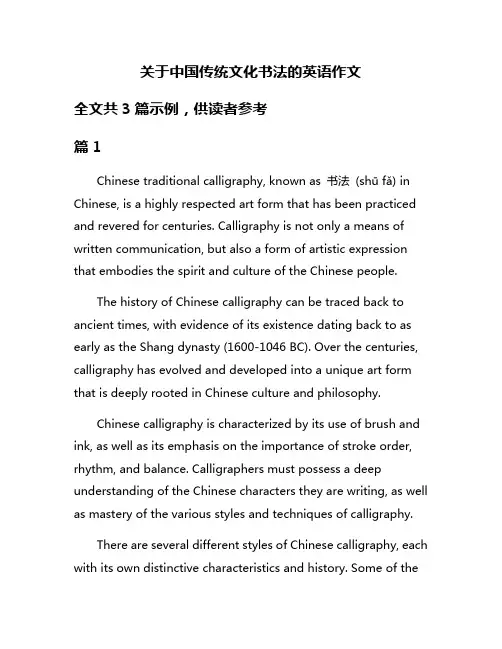
关于中国传统文化书法的英语作文全文共3篇示例,供读者参考篇1Chinese traditional calligraphy, known as 书法(shū fǎ) in Chinese, is a highly respected art form that has been practiced and revered for centuries. Calligraphy is not only a means of written communication, but also a form of artistic expression that embodies the spirit and culture of the Chinese people.The history of Chinese calligraphy can be traced back to ancient times, with evidence of its existence dating back to as early as the Shang dynasty (1600-1046 BC). Over the centuries, calligraphy has evolved and developed into a unique art form that is deeply rooted in Chinese culture and philosophy.Chinese calligraphy is characterized by its use of brush and ink, as well as its emphasis on the importance of stroke order, rhythm, and balance. Calligraphers must possess a deep understanding of the Chinese characters they are writing, as well as mastery of the various styles and techniques of calligraphy.There are several different styles of Chinese calligraphy, each with its own distinctive characteristics and history. Some of themost well-known styles include seal script (篆书), clerical script (隶书), regular script (楷书), running script (行书), and cursive script (草书). Each style requires a different level of skill and precision, making calligraphy a challenging and rewarding art form to master.In addition to its aesthetic value, Chinese calligraphy is also highly regarded for its cultural and spiritual significance. In Chinese culture, calligraphy is seen as a reflection of the writer's character, personality, and emotions. It is believed that the quality of one's calligraphy is a reflection of their inner self, and that practicing calligraphy can help to cultivate qualities such as patience, discipline, and tranquility.Furthermore, calligraphy is often used in Chinese traditional ceremonies, such as weddings, funerals, and important celebrations, to convey blessings and good wishes. Calligraphy is also used in the creation of traditional Chinese art forms, such as landscape paintings, poetry, and ceramics, further illustrating its importance in Chinese culture.Today, Chinese calligraphy continues to be practiced and revered by people of all ages and backgrounds around the world. The art form has transcended cultural boundaries and has become a symbol of Chinese cultural identity and heritage.In conclusion, Chinese traditional calligraphy is a beautiful and profound art form that embodies the spirit, history, and culture of the Chinese people. Its timeless beauty and enduring significance serve as a testament to the richness and depth of Chinese civilization.篇2Traditional Chinese calligraphy, also known as brush calligraphy, is an art form that has been practiced for thousands of years in China. It is a unique and important aspect of Chinese culture, reflecting the beauty and elegance of the Chinese language.The history of Chinese calligraphy can be traced back to ancient times, with the earliest known examples dating back to the Shang Dynasty (approx. 1600-1046 BCE). Calligraphy has been highly regarded in Chinese society for centuries, with scholars, poets, and artists alike all practicing the art form as a way to express their thoughts and emotions.One of the key features of Chinese calligraphy is its focus on the aesthetic qualities of the characters. Each stroke is carefully considered and executed, with a strong emphasis on balance, rhythm, and form. Different styles of calligraphy have developedover the years, each with its own unique characteristics and techniques.One of the most famous styles of Chinese calligraphy is the "regular script" (楷書), which emerged during the Han Dynasty (206 BCE - 220 CE) and remains popular to this day. Other styles include the "running script" (行書), "cursive script" (草書), and "seal script" (篆書), each with its own distinctive characteristics and charm.Chinese calligraphy is not just a form of writing, but also a form of art and self-expression. It requires years of practice and dedication to master, with calligraphers often spending hours each day perfecting their craft. Through the act of writing, calligraphers seek to achieve a sense of inner peace and harmony, connecting with the spirit of the brush and ink.In addition to its artistic and cultural significance, Chinese calligraphy also plays a practical role in Chinese society. It has been used for centuries as a means of communication, with important documents and official records often written in calligraphy. In modern times, calligraphy continues to be valued as a form of cultural heritage, with classes and workshops held around the world to teach this traditional art form to new generations.Overall, Chinese calligraphy is a key part of China's rich cultural heritage, embodying the beauty, elegance, and depth of Chinese civilization. It serves as a link to the past, connecting people to their ancestors and to the traditions that have shaped Chinese society for thousands of years. As a form of expression and communication, calligraphy continues to inspire and captivate people around the world, demonstrating the enduring power and beauty of this ancient art form.篇3Traditional Chinese calligraphy is a unique form of art that has been passed down through generations in China. With a rich history spanning thousands of years, Chinese calligraphy is not just a form of writing, but also a way of expressing beauty, culture, and philosophy.Chinese calligraphy has its roots in ancient China, dating back to the Shang Dynasty (c. 1600-1046 BC). It was initially used as a means of communication, with inscriptions on oracle bones and bronze vessels serving as the earliest examples of Chinese calligraphy. Over time, calligraphy evolved into a form of artistic expression, with famous calligraphers like Wang Xizhi, known as the "Sage of Calligraphy," leaving behind masterpieces that are still revered today.One of the most fascinating aspects of Chinese calligraphy is the brushwork used to create the characters. Calligraphers use a brush, ink, and paper to write, with each stroke carefully planned and executed. The brush must be held at the correct angle and pressure to achieve the desired effect, and the ink must be perfectly balanced to create crisp, flowing lines.In addition to the technical skill required, Chinese calligraphy also embodies the cultural and philosophical ideals of traditional Chinese society. Calligraphy is often seen as a reflection of the calligrapher's character, with the movements of the brush revealing their emotions and intentions. The imperfections and variations in each character are seen as a sign of the calligrapher's individuality and creativity.Chinese calligraphy is also imbued with symbolism and meaning. Each stroke and character has its own significance, with certain characters representing virtues like patience, wisdom, or harmony. Calligraphy is often used to convey deeper messages and ideas, with famous poems and sayings often written in elegant script to emphasize their beauty and importance.Beyond its artistic and cultural significance, Chinese calligraphy also plays a practical role in Chinese society. Calligraphy is still taught in schools as part of the traditionalcurriculum, and many people study calligraphy as a way to improve their handwriting and cultivate their artistic skills. Calligraphy is also used in official documents, ceremonies, and artwork, with calligraphers highly respected for their skill and expertise.Overall, Chinese calligraphy is a timeless art form that continues to captivate and inspire people around the world. Its beauty, elegance, and depth of meaning make it a true reflection of Chinese culture and history. As we celebrate and preserve this ancient tradition, we keep alive the spirit and essence of Chinese calligraphy for future generations to enjoy and appreciate.。
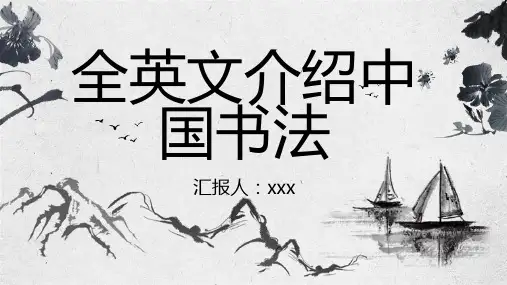
CalligraphyCalligraphy is understood in China as the art of writing a good hand with the brush or the study of the rules and techniques of this art. As such it is peculiar to China and the few countries influenced by ancient Chinese culture.In the history of Chinese art, calligraphy has always been held in equalimportance to painting. Great attention is also paid today to itsdevelopment by holding exhibitions of ancient and contemporary worksand by organizing competitions among youngsters and people fromvarious walks of life. Sharing of experience in this field often makes afeature in Sino-Japanese cultural exchange.Chinese calligraphy, like the script itself, began with the hieroglyphs and, over the long ages of evolution, has developed various styles and schools, constituting an important part of the heritage of national culture.ClassificationChinese scripts are generally divided into five categories:The seal character (zhuan), the official or clerical script (li), the regularscript (kai), the running hand (xing) and the cursive hand (cao).1) The zhuan script or seal character was the earliest form of writing afterthe oracle inscriptions, which must have caused great inconveniencebecause they lacked uniformity and many characters were written invariant forms. The first effort for the unification of writing, it is said, tookplace during the reign of King Xuan (827-782 B. C.) of the Western ZhouDynasty, when his taishi (grand historian) Shi Zhou compiled a lexicon of15 chapters, standardizing Chinese writing under script called zhuan. It isalso known as zhouwen after the name of the author. This script, oftenused in seals, is translated into English as the seal character, or as the"curly script" after the shape of its strokes.Shi Zhou's lexicon (which some thought was written by a later author of the state of Qin) had long been lost, yet it is generally agreed that the inscriptions on the drum-shaped Qin stone blocks were basically of the same style as the old zhuan script.When, in 221 B. C., Emperor Qin Shi Huang unified the whole of China under one central government, he ordered his Prime Minister Li Si to collect and sort out all the different systems of writing hitherto prevalent in different parts of the country in a great effort to unify the written language under onesystem. What Li did, in effect, was to simplify the ancient zhuan (small seal) script.Today we have a most valuable relic of this ancient writing in the creator Li Si's own hand engraved on a stele standing in the Temple to the God of Taishan Mountain in Shandong Province. The2,200-year-old stele, worn by age and weather, has only nine and a half characters left on it.2) The lishu (official script) came in the wake of the xiaozhuan in the same short-lived Qin Dynasty (221 - 207 B. C.). This was because the xiaozhuan, though a simplified form of script, was still too complicated for the scribes in the various government offices who had to copy an increasing amount of documents. Cheng Miao, a prison warden, made a further simplification of the xiaozhuan, changing the curly strokes into straight and angular ones and thus making writing much easier. A further step away from the pictographs, it was named lishu because li in classical Chinese meant "clerk" or "scribe". Another version says that Cheng Miao, because of certain offence, became a prisoner and slave himself; as the ancients also called bound slaves "li", so the script was named lishu or the "script of a slave".3) The lishu was already very close to, and led to the adoption of, kaishu, regular script. The oldest existing example of this dates from the Wei (220-265), and the script developed under the Jin(265-420). The standard writing today is square in form, non-cursive and architectural in style. The characters are composed of a number of strokes out of a total of eight kinds-the dot, the horizontal, the vertical, the hook, the rising, the left-falling (short and long) and the right-falling strokes. Any aspirant for the status of calligrapher must start by learning to write a good hand in kaishu.4) On the basis of lishu also evolved caoshu (grass writing or cursive hand), which is rapid and used for making quick but rough copies. This style is subdivided into two schools: zhangcao and jincao.The first of these emerged at the time the Qin was replaced by the Han Dynasty between the 3rd and 2nd centuries B. C. The characters, though written rapidly, still stand separate one from another and the dots are not linked up with other strokes.Jincao or the modern cursive hand is said to have been developed by Zhang Zhi (?-c. 192 A. D.) of the Eastern Han Dynasty, flourished in the Jin and Tang dynasties and is still widely popular today.It is the essence of the caoshu, especially jincao, that the characters are executed swiftly with the strokes running together. The characters are often joined up, with the last stroke of the first merging into the initial stroke of the next. They also vary in size in the same piece of writing, all seemingly dictated by the whims of the writer.A great master at caoshu was Zhang Xu (early 8th century) of the Tang Dynasty, noted for the complete abandon with which he applied the brush. It is said that he would not set about writing until he had got drunk. This he did, allowing the brush to "gallop" across the paper, curling, twisting ormeandering in one unbroken stroke, thus creating an original style. Today one may still see fragments of a stele carved with characters in his handwriting, kept in the Provincial Museum of Shaanxi.The best example and model for xingshu, all Chinese calligraphers will agree, is the Inscription on Lanting Pavilion in the hand of Wang Xizhi (321-379) of the Eastern Jin Dynasty. To learn to write a nice hand in Chinese calligraphy, assiduous and persevering practice is necessary. This has been borne out by the many great masters China has produced. Wang Xizhi, the great artist just mentioned, who has exerted a profound influence on, and has been held in high esteem by, calligraphers and scholars throughout history, is said to have blackened in his childhood all the water of a pond in front of his house by washing the writing implements in it after his daily exercises. Another master, Monk Zhiyong of the Sui Dynasty (581-618) was so industrious in learning calligraphy that he filled many jars with worn-out writing brushes, which he buried in a "tomb of brushes".Renewed interest in brush-writing has been kindled today among the pupils in China, some of whom already show promises as worthy successors to the ancient masters.Four Treasures of the StudyTo produce Chinese characters one will need a brush, paper, inkstick and ink stone, commonly referred to as the "Four Treasures ofthe Study". To learn calligraphy, it is necessary to learn about thesetools.While brushes are varied, white-goat-hair, black-rabbit-hair and yellow-weasel-hair brushes are the main ones. On the basis of function, brushes are classified into three groups: hard, soft and both. Brush handles are usually made of bamboo, wood, lacquer or porcelain; ivory or jade handles are rare and precious.The ink stick is a unique pigment used for Chinese traditional painting and calligraphy. The most famous ink stick ishui mo(Anhui ink stick), made of pines that grow on Huangshan Mountain in Anhui Province. Clean water is needed to grind the ink stick, which must be balanced in the hand during the grinding or rubbing process. Press hard and rub lightly, slowly and evenly against the ink slab until a thick, liquid-ink forms.Paper was invented by Cai Lun in the Eastern Han Dynasty (25-220). While paper comes in many varieties, Xuan paper, produced in the Jing Prefecture of Xuanzhou (today's Anhui Province), is considered the best for Chinese calligraphy. The paper is soft and fine textured, suitable for conveying the artistic expression of both Chinese calligraphy and painting. With a good tensile strength and mothproof quality, the paper can be preserved for a long time.Ink stones or ink slabs have been classified into three categories:Duan,SheandTao. Features common to all three ink slabs are the stone's hardness and fineness. Although the stone is hard and fine, it is notdry or slippery. Using a hard, smooth stone, liquid ink can be produced easily by rubbing the ink stick against the stone.By controlling the flexibility of the brush, the concentration of the ink and the absorbency of the paper, the artist can produce an infinite variety of calligraphic styles and forms.Calligraphy: Leader of All Art FormsFew nations in the world have calligraphy as a form of art. In China, calligraphy has maintained a close rapport with the country's cultural development.Calligraphy is an expressive art. According to an old Chinese saying, "the way characters are written is a portrait of the person who writes them." Expressing the abstract beauty of lines and rhythms, calligraphy is a reflection of a person's emotions, moral integrity, character, educational level, accomplishments in self-cultivation, intellectual tastes and approach to life. Chinese characters, which convey ideas, are regarded as the most abstract and sublime art form.Calligraphy is also a practical fine art. Exotic calligraphic inscriptions written on paper, wooden plaques or stone tablets serve as decorations of a deep artistic value.Calligraphy manifests the basic characteristics of all Chinese arts. Closely associated with paintings -- the two leaders of Chinese art forms -- calligraphy takes precedence over painting since it greatly inspired the art of painting. Moreover, calligraphy has influenced other typically Chinese art forms like classical poetry, seal-cutting, sculpture, traditional music and dance, architecture and handicrafts.Calligraphy is a mental exercise that coordinates the mind and body. It is a most relaxing yet highly disciplined exercise for physical and spiritual well-being. Historically, many calligraphic artists lived to a ripe, old age.An Art of the OrientChinese calligraphy is an Oriental art. Like chopsticks, calligraphy was once entirely Chinese, but as Chinese culture spread to Korea, Japan, and Singapore, calligraphy became a unique feature of the Oriental art.Calligraphy is even wildly accepted by the West; as once Picasso said, "Had I been born Chinese, I would have been a calligrapher, not a painter." Many calligraphic elements are being adopted by modern western art.。
关于中国书法的英文介绍Chinese calligraphy is an ancient and highly respected art form. It is a form of visual expression that uses strokes, characters, words and phrases to convey an artist’s innermost thoughts and emotions. Chinese calligraphy has a long history, which can be traced back more than 3,000 years.Chinese calligraphy is considered one of the highest forms of visual arts in Chinese culture. In fact, it is so important that it is often seen as a symbol of high social status and educational attainment. The art of Chinese calligraphy originated from the inscription on bones and tortoise shells during the Shang dynasty (16th to 11th century BC). During the Han dynasty (206 BC – 220 AD), the style of writing had already developed significantly, and due to its popularity with the upper classes, it had become government sanctioned and played a role in politics and religion.The four main script styles of Chinese calligraphy are: seal, clerical, running and regular script. Seal script is the earliest script and is still used today on seals, stamps and certain works of art. Clerical script was developed later and was primarily used by scholars and writers. Running script is slightly more modern and became popular during the Song and Tang dynasties. Regular script was developed during the Song dynasty and is the most commonly used script today.Chinese calligraphy has evolved over the centuries and many renowned calligraphers have put their own stamp on the art form. The level of skill achieved by master calligraphers is regarded admirably and highly respected in Chinese society. As such,Chinese calligraphy is regularly displayed in museums and galleries across China to share these masterpieces with the wider public.For those looking to learn this art, the fundamentals are relatively straightforward. Calligraphy is best practiced with brush, ink and paper. However, there are also digital tools available to ensure that calligraphers have access to the materials whenever and wherever they need them. Whether an experienced enthusiast or a novice, anyone can enjoy creating unique and timeless works of art. Therefore, Chinese calligraphy is an elegant and timeless art form with a rich history and culture behind it. It is a skill that requires patience and dedication, but through dedication and practice, even beginners can start to produce beautiful works of art.。
用英语介绍中国文化书法Chinese calligraphy, also known as "Shufa" in Chinese,is a traditional art form that has been practiced for thousands of years in China. It is considered one of the highest forms of Chinese visual art and is admired for its beauty, elegance, and cultural significance.The history of Chinese calligraphy can be traced back to ancient China, where it was used as a means of communication and expression. Over the centuries,calligraphy has evolved into a highly respected art form, with its own set of techniques, styles, and principles.One of the most distinctive features of Chinese calligraphy is the use of brush and ink to create characters. Calligraphers use a variety of brushes,typically made from animal hair, and black ink to write on paper or silk. The strokes of the brush are carefully controlled to create a harmonious balance of form, rhythm, and space.Chinese calligraphy is not just about writing characters, but also about expressing the calligrapher's emotions andpersonality. Each stroke is infused with the calligrapher's energy and spirit, making each piece of calligraphy aunique work of art.There are several major styles of Chinese calligraphy, each with its own unique characteristics and history. These styles include Seal Script, Clerical Script, Regular Script, Running Script, and Cursive Script. Each style has its own rules and conventions, and calligraphers often spend years mastering a particular style.In addition to its artistic value, Chinese calligraphy also holds significant cultural and philosophical meanings. It is often associated with concepts such as harmony, balance, and discipline, reflecting the core principles of traditional Chinese culture.Chinese calligraphy has also had a profound influence on other forms of art and culture, such as painting, poetry, and even martial arts. Many famous Chinese artists, scholars, and poets have also been skilled calligraphers, and their works have greatly enriched the cultural heritage of China.In modern times, Chinese calligraphy continues to thrive as a cherished art form, with many enthusiasts and practitioners around the world. It is often practiced as a form of meditation and mindfulness, offering a way to cultivate inner peace and self-expression.Overall, Chinese calligraphy is a rich and profound art form that embodies the essence of Chinese culture. It is a testament to the creativity, wisdom, and spiritual depth of the Chinese people, and it continues to inspire andinfluence artists and admirers around the world.中国书法,又称“书法”,是中国传统艺术形式之一,已有数千年的历史。
Calligraphy is an art form that has been cherished in China for thousands of years, deeply rooted in the countrys history and culture.It is not merely a means of writing but a reflection of the artists spirit,emotions,and aesthetic sensibilities.Origins and Historical SignificanceChinese calligraphy dates back to the Shang Dynasty16001046BCE,where inscriptions on oracle bones and bronze vessels marked the earliest forms of written Chinese.Over time,calligraphy evolved through various dynasties,each leaving its unique imprint on the art form.The Han Dynasty saw the development of the clerical and cursive scripts, while the Tang Dynasty is renowned for the perfection of regular script,known for its balance and symmetry.Styles and ScriptsThere are five major scripts in Chinese calligraphy:Seal Script Zhuan Shu,Clerical Script Li Shu,Regular Script Kai Shu,Running Script Xing Shu,and Cursive Script Cao Shu.Each script has its own characteristics and is suited to different expressions and moods.For instance,Seal Script is formal and ancient,while Cursive Script is freeflowing and dynamic.Tools of the ArtThe Four Treasures of the Study,which include the brush,ink,paper,and inkstone,are essential to the practice of Chinese calligraphy.The brush,made from animal hair,is chosen for its ability to hold ink and create varied strokes.Ink is made from soot and animal glue,and it is ground on an inkstone with water to the desired consistency.The paper,typically rice paper,is absorbent and allows for the ink to spread in a controlled manner.Techniques and PrinciplesMastering Chinese calligraphy requires discipline and practice.Calligraphers must understand the principles of balance,rhythm,and harmony.Stroke order and direction are crucial,as is the control of pressure and speed when using the brush.The art is not just about replicating characters but about expressing the inner spirit and character of the calligrapher.Cultural and Philosophical SignificanceCalligraphy in China is often seen as a reflection of the calligraphers moral character and cultivation.It is believed that ones calligraphy can reveal their inner self,much like how a persons actions and behavior can.The practice of calligraphy is also a form of meditation and selfcultivation,helping to calm the mind and refine ones character.Modern CalligraphyIn contemporary times,Chinese calligraphy continues to be appreciated and practiced, not only in China but around the world.It has become a symbol of cultural exchange and a means for people to connect with Chinese culture.Modern calligraphers often experiment with new materials and styles,blending traditional techniques with contemporary themes.ConclusionChinese calligraphy is a profound and multifaceted art form that encapsulates the essence of Chinese culture.It is a living tradition that continues to evolve,offering a window into the soul of China and a pathway for personal expression and cultural understanding. Whether one is a practitioner or an admirer,the beauty and depth of Chinese calligraphy offer a rich and rewarding experience.。
向外国朋友介绍中国传统文化的英语作文英文版:Dear friends,I would like to introduce you to one of the most fascinating aspects of Chinese traditional culture - Chinese calligraphy. With a history of over 3,000 years, Chinese calligraphy is not only a form of art but also a way to cultivate one's mind and express emotions.In ancient China, calligraphy was considered one of the four essential skills that scholars must master, along with playing the guqin (a stringed instrument), playing go (an ancient board game), and painting. The tools used in calligraphy - brush, ink, paper, and inkstone - are known as the "Four Treasures of the Study."The beauty of Chinese calligraphy lies in its balance, composition, and the expression of the calligrapher's spirit. Each stroke, whether it is thick or thin, long or short, conveys a different emotion and energy. The way the characters are arranged on the paper also reflects the calligrapher's artistic sense and understanding of space.Learning Chinese calligraphy not only helps one appreciate the beauty of Chinese characters but also cultivates patience, concentration, and inner peace. It is a practice that allows one to slow down, focus on the present moment, and express oneself through the art of writing.I hope this brief introduction has piqued your interest in Chinese calligraphy. It is truly a gem in the treasure trove of Chinese traditional culture, and I encourage you to explore it further.Best regards,[Your Name]中文版:亲爱的朋友们:我想向大家介绍一下中国传统文化中最迷人的方面之一——中国书法。